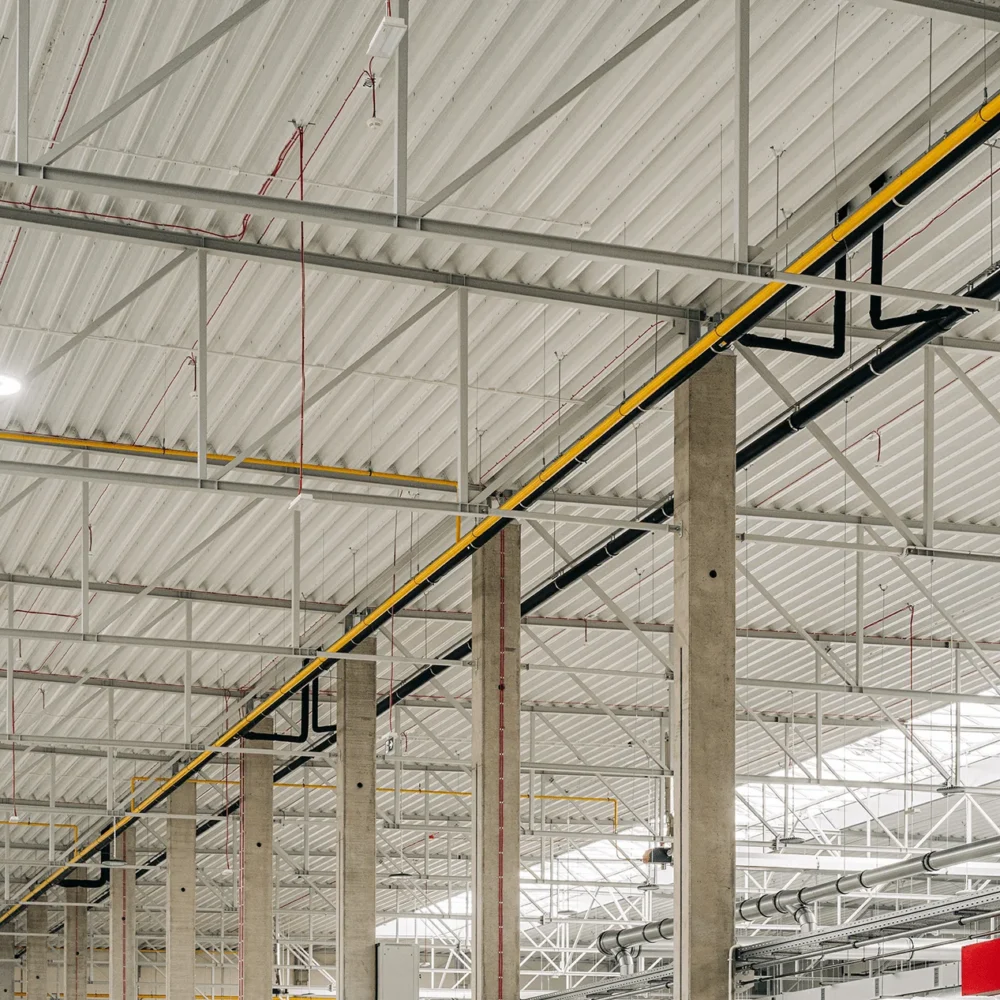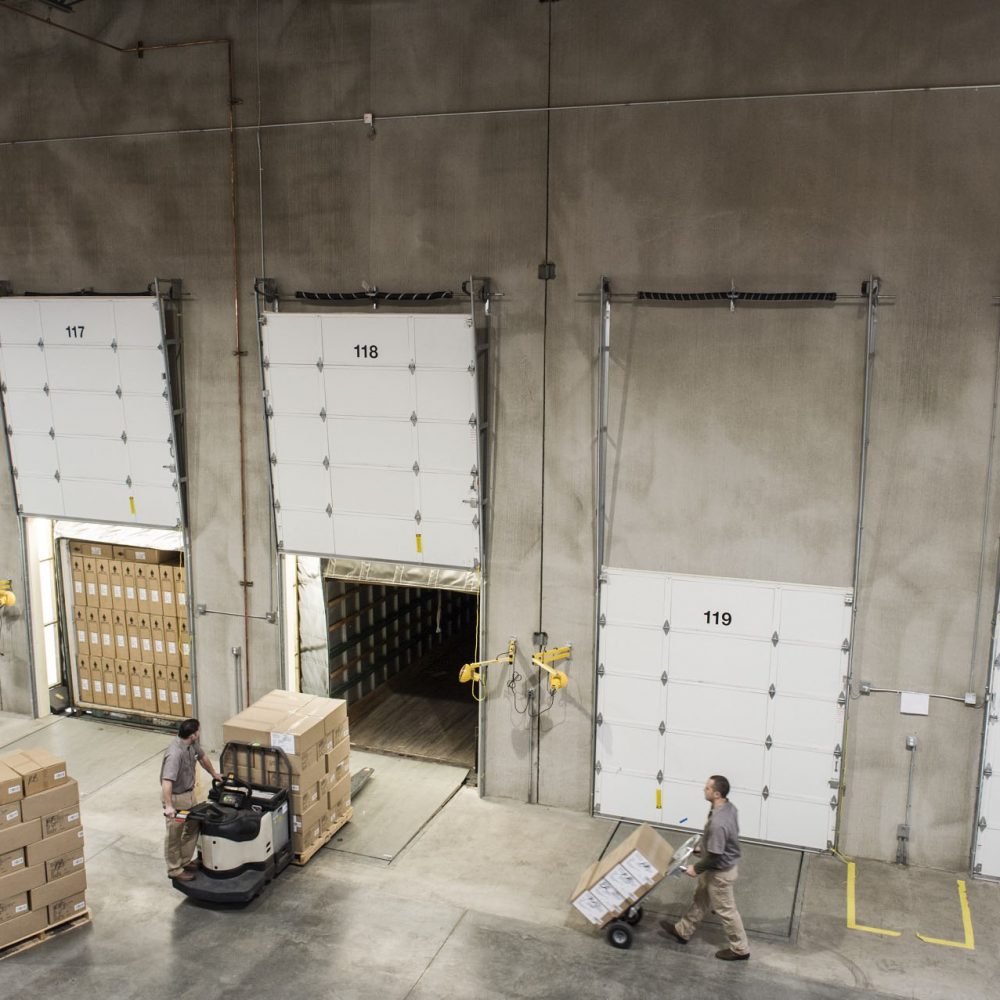
When constructing large-area buildings, framework structural systems are most commonly used, in which the main load-bearing structure consists of roof beams supported by columns, which in turn are supported by point foundations known as footings. In the field of framework structures, a basic division of the main structural elements can be made according to the material, i.e. steel and reinforced concrete components. The following sections outline the specifics of structures built with these two technologies, focusing on the main advantages and disadvantages of the aforementioned solutions.
Steel structures
Structural steel is a material characterised by very high compressive and tensile strengths and offers a high modulus of elasticity. These properties mean that load-bearing structures made of structural steel can be extremely slender and thus lightweight, often making it possible to achieve very long spans. Structural steel is a weldable material, which gives great freedom in shaping of components. You can therefore expect high aesthetics from steel structures which is often easy to achieve. However, these structures do have some drawbacks. Steel is susceptible to degradation by corrosion. The rate and nature of the corrosion process is influenced by a wide range of environmental factors, such as ambient temperature and humidity, ambient pH and the action of chemical substances resulting from the processes in the facility which promote corrosion (e.g. the presence of sulphur dioxide, sulphur, hydrogen chloride, hydrogen sulphide, halogens, etc.). Steel structures are most often protected against the above conditions by coating systems or by galvanising the structure, with is jointly referred to as protective coatings.
As for the technical solutions commonly found in the field of steel construction, a distinction can be made between halls with solid-wall girders and halls with lattice girders. Both of the above solutions consist in forming a repetitive construction frame spaced at spans of several metres, which determines the shape to the structure. The internal columns of both solutions can be spaced at longer spans in relation to the façade columns by using additional girders perpendicular to the above frames. Such girders are known as the sub-girders. This solution results in large interior areas with great freedom of space arrangement.
Steel structures are prepared in specialised prefabrication plants. The prefabricated structural components are assembled on site. Steelwork components are usually joined together on site using bolts and other fasteners, ensuring that the desired joint strength is achieved immediately. Thus, achieving the assembly capacity of several thousand square feet per workweek for typical warehouse/production structures does not pose a challenge to Commercecon.
Reinforced concrete structures
Reinforced concrete structures consist of elements that functionally correspond to those found in the steel structures mentioned earlier. They consist of girders supported on columns, which, as mentioned, also rest on the footings.
Structures made of concrete reinforced with steel (nowadays also sometimes composite) elements, usually in the form of ribbed round bars, are referred to as the reinforced concrete structures. Without going into technical details, it is worth mentioning that concrete is a material with inherently lower tensile strength vs. the compressive strength, and thus commonly called a “brittle” material. This is the mentioned poorer mechanical-strength performance that makes the reinforced concrete structures more massive in comparison with steel structures. For the reinforced concrete girders or precast floor slabs with a long span, it is often necessary to exert additional compressive force, and, as such, they are known as the prestressed reinforced concrete component (prestressed or post-tensioned, depending on the prestressing technology).
However, reinforced concrete structures have advantages that cannot be found in steel structures. The unquestionable advantage of reinforced concrete structures is their fire performance – they have a natural fire resistance. Proper design of a reinforced concrete structure means that its load-bearing elements usually do not require additional protection against the effects of fire.
The main structural parts of reinforced concrete halls, as with the steel halls, are manufactured by special pre-casting plants. The delivered components (however multiple times heavier than their steel counterparts) are assembled on site. Due to the specific nature of reinforced concrete construction, some solutions sometimes require the so called bonding of precast elements. The bonding of reinforced concrete parts is made out by pouring high-strength concrete into specially designed junctions. Without going into the technical details, note only that the bonding may not be performed in freezing temperatures and therefore it is a disadvantage as opposed to steel halls.
Hybrid halls
What if the builder expects both high fire resistance and a fast construction? Are steel halls better than reinforced concrete halls? Or is a reinforced concrete hall better than a steel hall? Steel or reinforced concrete – which option to choose?
We would like to draw your attention to hybrid halls, another design solution that we commonly use at Commercecon. With this type of construction we skilfully exploit the advantages of steel and reinforced concrete construction. In a hybrid hall, the columns are made of reinforced concrete and the roof structure of steel.
Reinforced concrete columns make it easier to meet the fire protection requirements of the building. Furthermore, it is becoming increasingly common for Commercecon to join reinforced concrete columns to the footing using accessory bolt fasteners, without monolithic reinforced concrete joint joints that need to be made at positive temperatures or artificially reheated at freezing temperatures.
Hall roof structures seldom require such stringent fire protection measures which is why steel roofing is provided. The steel roof structures of hybrid halls are incomparably lighter, slimmer and therefore quicker and easier to install than those found in traditional reinforced concrete halls.
Steel or reinforced concrete hall – which one to choose?
Hall roof structures often do not require such rigorous protection measures.
In the search for an optimum solution, it is worth taking into account the characteristics of steel halls, reinforced concrete halls and hybrid halls presented in the text. The above guide will certainly help the Investor to ask additional questions as well, which the Commercecon team will be happy to answer.
Find out more about our range of industrial buildings.



